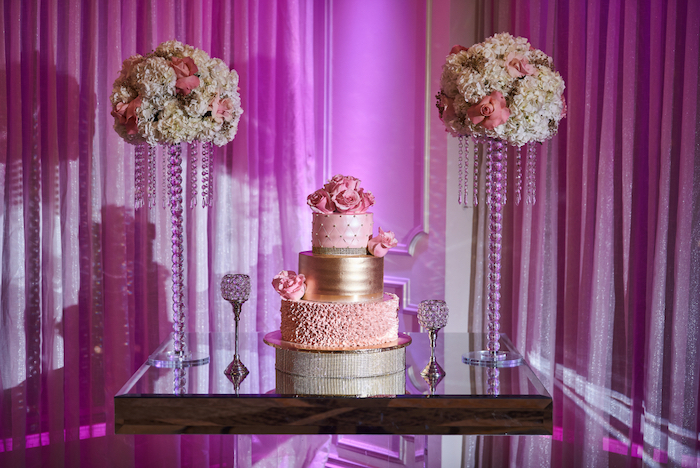
The Quinceañera dates back centuries. It has cultural roots in Mexico and is now celebrated across Latin America, and the Caribbean, as well as Latino communities throughout the United States and across the globe. Also known as ‘Quince Anos’ or ‘Quinces’, this tradition celebrates an important milestone in a girl’s life – her 15th birthday. It marks the transition from girlhood to womanhood, a coming-of-age moment where girls can finally wear makeup, and high heels and go on a date. Similar to a ‘Sweet 16’ in the United States, Hispanic countries mark the occasion with an extravagant party. The celebration kicks off with a mass, followed by a reception featuring food, drinks and dancing. Unlike the American ‘Sweet 16’, La Quinceanera is rich in local customs and traditions. Looking to learn more about this traditional Latino and Hispanic celebration? From a ‘Court of Honour’ to china dolls, here are a few interesting Quinceanera traditions to get you started.
Latin American Quinceanera traditions
1. The Court of Honour
The Court of Honour is similar to a bridal party, a close-knit group of friends and family that get to participate in the celebrations like VIPs. The Quinceanera’s Court of Honour can include both girls (damas) and boys (chambelanes). Traditionally, the group comprises 14 of each, though families often shrink it down to seven of each nowadays.
The court will usually accompany the birthday girl down the aisle. The group will usually wear matching gowns and the boys wear suits. They also perform a special waltz at the reception. Quite the responsibility.

2. The ceremony
The celebrations usually kick off with the ceremony or mass. Much like a wedding, the birthday girl will enter the church in a procession, accompanied by her court of boys and girls, as well as her parents and grandparents. During the service, she renews her baptismal promise and commits herself to God and the Virgin Mary. The birthday girl will usually get to pick her own readings to make them more meaningful. She can either choose to read them out herself or pick someone else to do it for her.

The quinceañera always dances with her father first, to a song he has chosen that holds special significance to both of them. This would have once represented a girl’s first public dance. After the dance, the father hands the quinceañera over to her escort. At this point, tradition dictates that the court of honour breaks into a choreographed dance, typically a waltz. Some families even choose to hire a professional choreographer to map out the routine. After the dance, the father changes the birthday girl’s flat shoes to high heels, which symbolises the transformation from girl to woman.

4. Presents, presents, presents
Like any other birthday, the quinceañera will receive lots of lovely gifts. Unlike most birthdays, these might include traditional items such as a rosary, a medal or a bible. One tradition dictates that grandparents gift 15 red roses, where the petals signify sweetness and the stems represent strength. The family will also usual gift regal related items, such as a tiara and a sceptre.
The “last doll” is probably the most famous quinceañera gift. Usually made from porcelain and dressed like the quinceañera herself, her parents will present the doll to mark her passage into adulthood. Some pin ribbons and engrave the doll too.

5. The sponsors
All of this partying sounds expensive for the parents, eh? Actually, much – or at least part – of the costs fall on the birthday girl’s ‘sponsors’. Sponsors will usually pay for part of the party, such as the cake, the DJ or the catering. Older family members and family friends will usually chip in too.

Much like a wedding dress, the quinceañera gown is as important as a wedding dress. The Duchess of Alba in Spain started the custom, and quinceañera dresses have followed a similar suit ever since. Girls will usually wear an elegant ball gown made with layers of tulle, taffeta or silk. There’s no traditional colour, though it’s rare to stray out of the realms of pretty pastels. Most girls opt for white or pink. While it might be a young woman’s first foray into womanhood, the dresses are still typically modest. The dresses often feature shawls or jackets that can be removed for the party.

7. The food
No party would be complete without a feast and, in true Latin American tradition, a quinceañera showcases some of the best dishes in town. Once upon a time, preparing the meal would’ve fallen to the family and the local community. Nowadays, people usually hire a caterer to provide the meal, like a wedding.
Specific dishes vary from country to country, as well as social class. In Mexico, La Quinceanera feast usually includes different types of enchiladas, rice and beans, corn-wrapped tamales and a variety of tacos. Barbecues and fajita buffets are also popular, as well as mole. In Peru, cuasas, choros a la chalaca and picarones are particularly popular.
Every feast will culminate in a classic quinceañera cake. Usually an almond meringue cake or a sponge cake, it’s usually as large and extravagant as possible.

The post 7 Quinceanera Traditions appeared first on Big 7 Travel.

